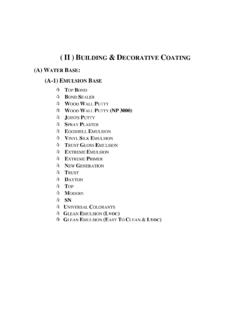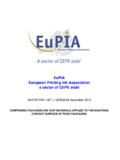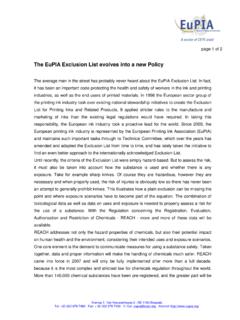Transcription of I General - NationalPaints
1 ( I ) General . TECHNICAL TERMS. SURFACE PREPARATION. HEALTH & SAFETY. PAINT APPLICATION. AIRLESS SPRAY APPLICATION TROUBLE SHOOTING CHART. CONVERSION TABLES. 1/16. TECHNICAL TERMS. In order to comprehend fully the technical data sheets and the various types of paints and painting methods, it is essential for the reader to have a fair knowledge of the terms used. MICRON ( ): Metric unit used to designate film thickness. 1 micron = 1 mm / 1000 (One thousandth mm) = m (One-millionth m). Also written as m or um. MIL: American unit used to designate film thickness. Also called "thou". 1 mil = microns . 25 microns. VOLUME SOLIDS: Volume Solids of paint is the ratio of the nonvolatile components present in it to the total volume. Also termed as Solid Volume Ratio (SVR) or SV%. This is the most important factor which determines the coverage of paint, others being thickness at which paint is applied, nature of surface being painted, method of application etc.
2 DRY FILM THICKNESS ( ): The thickness of the paint film is measured in microns when it is dry. An adequate film thickness is mandatory for the success of any coating system. Under application will result in premature failure of the paint system. Exceeding the specified film thickness can be equally dangerous. The recommended depends on the type of paint system and nature of surface. WET FILM THICKNESS ( ): The thickness of the wet film is measured in microns immediately after application. Measuring is essential to keep the at the desired level, by applying the paint at a pre-judged ; calculated by the following equation:- WFT = DFT x 100. SVR. THEORETICAL SPREADING RATE ( ): The area covered by unit amount of paint when applied is referred to as Theoretical Spreading Rate or simply Spreading Rate at a particular Since is a function of DFT, it should be clearly specified while stating It is calculated by the following equation: (m2/litre) = SVR x 10.
3 DFT (microns). THEORETICAL PAINT CONSUMPTION: Theoretical Paint Consumption (liters) = AREA (M2). 2/16. PRACTICAL SPREADING RATE ( ): Practical Spreading Rate is calculated from by providing the appropriate loss factor. FLASH POINT: The lowest temperature, at which the solvent in the paint gives off sufficient vapour to form ignitable mixture with the air above its surface. TOUCH DRY: When a very light pressure with the finger does not leave a mark on the surface. DRY TO HANDLE: When the paint surface is sufficiently hardened to be freely handled without damage. HARD DRY: When the drying has reached such a stage that if desired, a further coat can be satisfactorily applied. SPECIFIC GRAVITY: Weight in Kgs per liter of paint at 25 C. CURING AGENT: Is the component which produces the chemical reaction linking the molecular chains of the binder together in original structure.
4 CURING: Hardening of the liquid paint by heat or by chemical reaction. POT LIFE: The chemical reaction sets in immediately after the component of two-component paint is mixed, which starts thickening / gelling. The period after mixing the components during which the paint remains usable is called pot-life. Pot-life depends on the temperature. SHELF LIFE: The time that paint will remain in good, usable condition when stored in the original sealed container under normal storage conditions. SHOPPRIMER: A shopprimer is used to protect derusted "steel" against corrosion during the storage and erection period until the ultimate protective paint system can be applied. HIGH BUILD PAINT: A paint that can produce thick dry films per coat. 3/16. SURFACE PREPARATION. SURFACE PREPARATION: For any given paint system, surface preparation is the single important factor that would determine its performance.
5 Various surface preparation methods are adopted depending on the requirements of the paint system used and the substrate. The substrate could be steel, galvanized steel, aluminum, concrete or wood. a) STEEL AS SUBSTRATE: Various methods of surface preparation are adopted viz. degreasing, high pressure fresh water hosing, hand tool cleaning, power tool cleaning, blast cleaning etc. Degreasing is done to remove all oil and grease prior to manual or blast cleaning. The most common method is by solvent washing followed by wiping dry with clean rags. A suitable detergent solution can also be used, and then the substrate has to be subjected to fresh water hosing to remove traces of detergents. The following are the most important surface preparation standards commonly followed worldwide. 1- Swedish Standard SIS 05 59 00 - (1967 - Pictorial Surface Preparation Standards for Painting Steel Surface).
6 2- Steel Structures Painting Council (SSPC), 3- British Standards Institution - Surface Finish of Blast Cleaned Steel for Painting (BS. 4232). 4- International Standard ISO 8501-1 : 1988. Except for BS 4232, all other standards consider the state of steel surface to be painted by classifying it into various grades A, B, C and D. Steel surface with mill scale but little rust is graded A, and surface which has begun to rust and from which mill scale has begun to flake is graded as B, surface from which mill scale has rusted away with slight pitting is graded C and surface with General pitting visible is grade D. The Swedish Standard being the prominent among all will be discussed in details. 4/16. SWEDISH STANDARD SIS 05 59 00 - 1967: The four grades for blast cleaning according to this standard are Sa 3, Sa , Sa 2 and Sa 1.
7 SA-3 : Blast cleaning to visually clean steel. Surface should be completely free from oil, grease, mill scale and rust. : Very thorough blast cleaning to achieve near white metal inferior to SA-3. SA-2 : Widely known as commercial blast inferior to SA-1 : Light blast cleaning to remove mill scale, rust and paint. ST-3 : Very thorough power tool cleaning to remove loosely adhering mill scale, paint and rust. However, it cannot remove tightly adhering mill scale. ST-2 : Loosely adhering mill scale, rust and old paint coatings are removed from steel by wire brushing, sanding, scraping and chipping. International Standard ISO 8501 - 1 - 1988 makes use of the same photos as used by Swedish Standard with the help of four additional photos from German Standard DIN 55928. British Standard BS 4232 - 1967 classifies blast-cleaned surfaces into three categories viz.
8 First Quality, Second Quality and Third Quality based on the proportion of the clean bare metal to the total area. For First Quality, 100% area should be clean bare metal, for Second Quality, at least 95%. of the area should be clean bare metal and for Third Quality, it should be at least 80%. The following chart gives an approximate equivalence between various standards:- Swedish Standard British Standard Steel Structures Painting Council SIS 055900 BS 4232 USA SSPC. SA-3 First Quality SSPC-SP5. Second Quality SSPC-SP10. SA-2 Third Quality SSPC-SP6. SA-1 ------ SSPC-SP7. ANCHOR PATTERN OR SURFACE PROFILE:- Surface texture of a metal, produced by abrasive blasting, to assist the adhesion of a coating, is called anchor pattern or surface profile. Most paint systems, specially inorganic zinc coatings, require an anchor pattern-characterized by a surface roughness and a roughness profile to obtain proper adhesion.
9 It is usually assessed by standardized comparator viz. Rugotest and Keane- Tator Surface Profile Comparator. Anchor pattern obtained depends on the type of abrasive used for blasting. Using fine sand of mesh size 80, maximum height of profile is found to be 35-37 microns whereas with iron shot of mesh size 14, it is found to be 90 microns. 5/16. b) GALVANIZED STEEL AND ALUMINUM AS SUBSTRATES:- Galvanized metal as well as aluminum presents a very difficult surface for painting because of the problem of getting proper adhesion of the paint system to the surface. Galvanized metal is very smooth which poses a serious threat to adhesion. So, it is imperative that an etch primer be applied on the surface subsequent to degreasing before the application of a proper paint system. Application of the etch primer results in a tacky surface which ensures proper adhesion of the paint system to the surface.
10 C) CONCRETE AS SUBSTRATE:- Although concrete appears as a dense, homogeneous material it contains a lot of small pores, which, if opened, contribute to a faster breakdown of the concrete. Fresh concrete possesses an alkalinity of up to pH 13. This alkalinity protects the reinforcement against corrosion. Reinforcement steel starts to corrode when pH of the moisture in the concrete is lower than 9. This happens due to the following reaction: Ca(OH)2 + H2CO3 ----- Ca CO3 + 2H2O (Carbonation). Ca(OH)2 + H2SO4 ------ Ca SO4 + 2H2O (Carbonation). Both H2CO3 (Carbonic acid) and H2SO4 (Euphoric Acid) are reaction products of CO2 and SO2. present in the atmosphere. Another troublemaker is laitance. Laitance is a thin layer of surplus cement and water that rises to the surface during setting of concrete. Unless removed, it will severely reduce adhesion and cause failure of the paint system.



